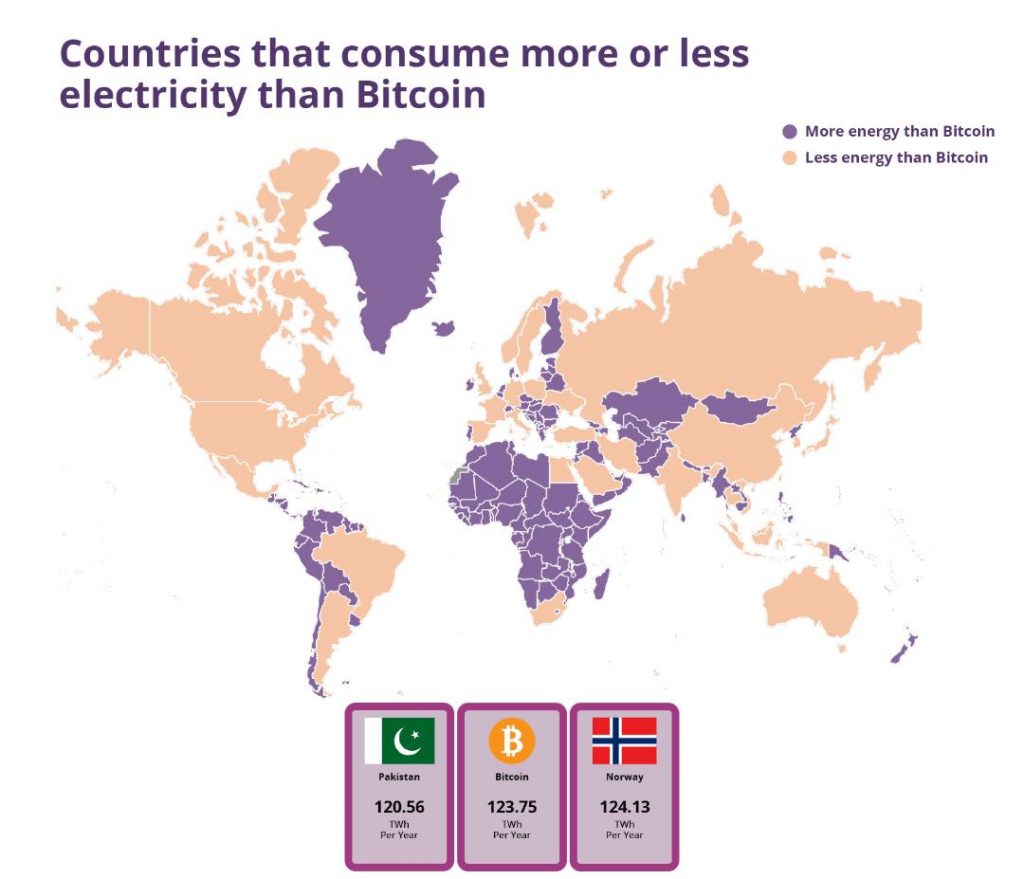
By Vinoth Venkatesan.
The Republic of Kosovo has banned crypto mining activities as a means of tackling its energy crisis. Russia is also looking to ban crypto mining as it “hurts the country’s green agenda”. The leading cryptocurrency blockchains like Bitcoin, Ethereum, Litecoin, etc., use the Proof of Work (PoW) that consumes a more significant deal of electricity than many nations in the world.
The report from MoneySuperMarket shows how countries consume more or less power than Bitcoin. The below chart from MoneySuperMarket is terrifying to see the level of energy consumed by the Bitcoin network alone.

Bitcoin uses a consensus known as proof of work, as do a few other major cryptocurrencies, including Ethereum, Bitcoin Cash, and Litecoin. Nevertheless, a growing number of platforms, such as Solana, Avalanche, and Cardano, are now leveraging an alternate known as proof of stake, which consumes much less energy.
PoS vs PoW – Quick Look
These consensus mechanisms are intended to do similar activity on a distributed network of contributors to agree on which new block of transactions is added to a cryptocurrency’s digital ledger, known as a blockchain. But they vary in how they reach their end goal.
For its part, proof of work allows agreement on which block to add by requiring network participants to expend tremendous amounts of computational resources and energy on producing new valid blocks. Proof of stake necessitates network participants to stake cryptocurrency as collateral, favouring the new block they trust should be added to the chain.
What is Proof of Stake?
Proof of stake spins around a process known as staking. This is something like voting, although, with most proof-of-stake cryptocurrencies, the method doesn’t involve “one person, one vote.” Instead, members — known as validators — stake a certain amount of crypto behind the block they want to be added to the chain. Different blockchains set different limits for this amount.
In the proof of stake, cryptocurrency holders’ vote’ to approve valid transactions. The reward for voting on legitimate transactions, ‘stakers’ are compensated for the newly created cryptocurrency over time. One primary benefit of proof of stake is that it avoids the need to invest increasing sums of money in ever-more-powerful computing equipment that consumes a massive amount of electricity.
Proof of stake also promises superior scalability and performance than proof of work since transactions and blocks can be validated and approved more quickly, without the need for complex equations to be solved.
Two significant benefits of proof of stake over proof of work are that PoS can be less energy-intensive and have greater transaction throughput (speed) and capacity.
There are two substantial concerns here, proof of stake can incline toward centralization because there is no limit on how much crypto a single validator could stake. While its environmental credentials are remarkable because it uses less energy, the approach hasn’t been proven on the scale that proof-of-work platforms have.
While there are questions about whether proof of stake can prove itself, it benefits from incorporating procedures to ensure that validators behave well and approve only valid blocks.
What is Proof of Work?
Where proof of stake comprises a competition to see which new block has the most crypto staked in its favour, proof of work consists of a contest to see which new block has the maximum computational work performed in its turn.
Proof-of-work networks such as Bitcoin enable all the nodes (computers) on the network to be the first to solve the computational effort and prove their work to add the latest set of transactions to the blockchain and earn some bitcoin in exchange. The main forte of proof of work is that requiring an increasingly significant investment in energy makes it exponentially difficult for a would-be bad actor to verify invalid blocks and double-spend the cryptocurrency.
That said, PoW consumption of energy has become contentious. The more computers you need to ensure the network is robust and functioning; the more energy is consumed.
In addition to the electrical energy, the ever-increasing amount of computing power needed to compete on a proof-of-work network is causing a problem with electronic waste as participants dispose of outdated systems and replace them with more advanced ones.
Another strength of proof of work is that, because it’s based on open competition between miners, it is viewed as more democratic and decentralized than proof of stake.
Final Words
PoW and PoS are two types of mechanisms used by cryptocurrencies for achieving consensus on which new blocks to add to their blockchains. They each solve the fundamental problem of validating transactions without using a central authority.
Proof of stake attains consensus by requiring participants to stake crypto behind the new block they want to be added to a cryptocurrency’s blockchain. Meanwhile, proof of work accomplishes consensus by requiring participants to spend computational power and electricity to generate a new valid block.
Proof of work has the benefit of making it significantly hard to break a cryptocurrency’s network, yet it comes at a mounting environmental cost. While proof of stake eliminates the massive energy consumption, it hasn’t been established to be as secure and stable as proof of work at scale.
The leading blockchain network Ethereum is being upgraded to the latest version, Ethereum 2.0 (known as Serenity), which will be based on proof of stake, is excellent evidence that PoS can be implemented and used at scale. This change will bring “scalable, environment-friendly, secure, and sustainable” blockchain networks.
About the Author
Vinoth Venkatesan
Vinoth is a cybersecurity professional by heart with over two decades of experience in Information Technology and Cybersecurity. He is an Australian Computer Society (ACS) Senior Certified Professional in Cybersecurity and holds various industry-leading cybersecurity credentials. Vinoth loves to write about the latest cybersecurity happenings and blockchain-related articles.






